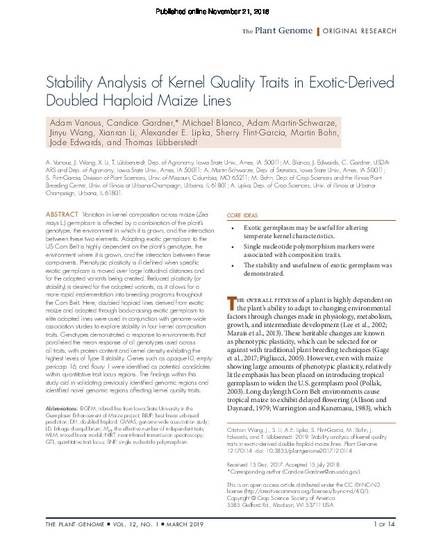
Variation in kernel composition across maize (Zea mays L.) germplasm is affected by a combination of the plant’s genotype, the environment in which it is grown, and the interaction between these two elements. Adapting exotic germplasm to the US Corn Belt is highly dependent on the plant’s genotype, the environment where it is grown, and the interaction between these components. Phenotypic plasticity is ill-defined when specific exotic germplasm is moved over large latitudinal distances and for the adapted variants being created. Reduced plasticity (or stability) is desired for the adapted variants, as it allows for a more rapid implementation into breeding programs throughout the Corn Belt. Here, doubled haploid lines derived from exotic maize and adapted through backcrossing exotic germplasm to elite adapted lines were used in conjunction with genome-wide association studies to explore stability in four kernel composition traits. Genotypes demonstrated a response to environments that paralleled the mean response of all genotypes used across all traits, with protein content and kernel density exhibiting the highest levels of Type II stability. Genes such as opaque10, empty pericarp 16, and floury 1 were identified as potential candidates within quantitative trait locus regions. The findings within this study aid in validating previously identified genomic regions and identified novel genomic regions affecting kernel quality traits.
Available at: http://works.bepress.com/thomas-lubberstedt/90/

This article is published as Vanous, Adam, Candice Gardner, Michael Blanco, Adam Martin-Schwarze, Jinyu Wang, Xianran Li, Alexander E. Lipka et al. "Stability Analysis of Kernel Quality Traits in Exotic-Derived Doubled Haploid Maize Lines." The Plant Genome 12 (2018): 1-14. doi: 10.3835/plantgenome2017.12.0114.